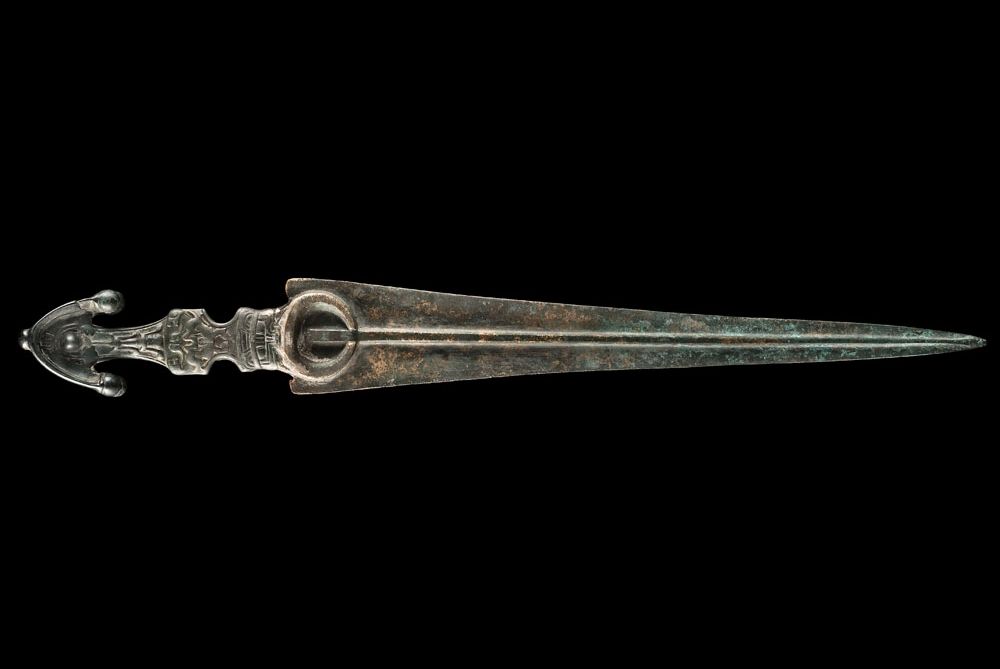Persian Bronze Sword w/a Fan-Shaped Hilt
Sept 5, 2015 2:35:29 GMT
Post by Jack Loomes on Sept 5, 2015 2:35:29 GMT


Period : Early 1st millennium B.C.
Dimensions : L: 50 cm
Price : CHF 18'000.00, USD 18.509.40, EUR 16.605.00
Provenance : Acquired on the English art market (London), 1997.
Conditions : Complete sword, though a flange of the hilt possibly restored; surface of the hilt slightly worn. Copper-colored metal with a black and partially green (lower blade) patina.
Reference 7834
The long thin triangular blade is reinforced by a long vertical rib in relief and, near the fitting at the top, by a thick circle. The thinness and the lack of holes for hilt rivets suggest that the weapon was cast as a single piece by the main manufacturing process that was used for daggers between the late Bronze Age and the early Iron Age; this technique allowed the blacksmith to avoid the disadvantages associated with the assembly of the hilt and blade, but it would not enable him to repair the sword when the blade was broken.
The most interesting and elaborate element is the hilt, whose inventive structure is composed of: a) the pommel in the shape of a double fan, adorned with large knobs attached to the ends and to the top parts; b) the grip, with its contrasting and sinuous outline, featuring a decoration in low relief organized on three levels; on the upper part, an enigmatic pattern recalls the body of an animal seen from above, its head directed downwards; at the center, two heraldic lions are seen in profi le, standing upright, each balancing on one leg; on the lower part, the crossguard, virtually non-existent, is replaced by the fl attened mask of a lion seen from above; following a type that is well attested by other examples, the lion, its mouth wide open but without a lower jaw, appears to spit the blade of the sword (see n. 1, 7, 14). The very particular style is characterized by the delicate lines that the blacksmith used to embellish the decoration; as often documented in artistic works of the same period in Western Asia, and despite the superfi cial wear, it is noteworthy that, for the lion’s head especially, many anatomical details became a good excuse to create new geometric patterns, circular or straight-lined, regardless of the meaning of the image (folds of the skin, ears, eyes).
Considering its thinness and hence its fragility, this sword might have been a ceremonial weapon or an off ering, rather than a weapon of war. The dating of the sword raises some problems because the triangular blade reinforced by a more or less complete crescent moon soldered beneath the crossguard is rather typical of the last centuries of the 2nd millennium B.C., while the highly stylized decoration of the hilt recalls more recent objects, rather dated to the 9th-8th century B.C. The later dating would be favored, since the data from Iranian excavations (Marlik for example) indicate a protracted period of use for such long daggers (fi rst centuries of the 1st millennium B.C.) and since this type appears in a very renowned worship scene, namely that on the Hasanlu gold bowl (generally dated between the 11th and the 8th century B.C.). A famous silver sword hilt, now in the British Museum, in London, is the closest parallel for our example, both in shape and in decoration.
Bibliography
On related swords, see:
CALMEYER P., Datierbare Bronzen aus Luristan und Kirmanshah, Berlin, 1969, pp. 122-127 (fi g. 130 on the silver sword hilt).
MUSCARELLA O.W., Bronze and Iron: Ancient Near Eastern Artifacts in the Metropolitan Museum of Art, New York, 1989, pp. 102 ff., nos. 169-170.
NEGAHBAN E.O., Marlik: The Complete Excavation Report, Philadelphia, 1996, pp. 262-263, fi g. 32, pl. 121.
On the Hasanlu gold bowl and the silver sword hilt, see:
GHIRSHMAN R., The Art of Ancient Iran, New York, 1964, pp. 28-29, fi g. 30-31 (bowl) and p. 66, fi g. 83 (hilt).
On dagger and sword manufacturing processes, see:
DE WAELE E., Bronzes du Luristan et d’Amlash: Ancienne Collection Godard, Leuven, 1982, pp. 48 ff. MAXWELL-HYSLOP K.R. and HODGES H.W.M.,
A Note on the Significance of the Technique of “Casting on” as Applied to a Group of Daggers from North-West Persia, in Iraq, 26, 1964, pp. 50 ff.
Source: www.phoenixancientart.com/work-of-art/sword-with-a-fan-shaped-hilt

.png?width=1920&height=1080&fit=bounds)